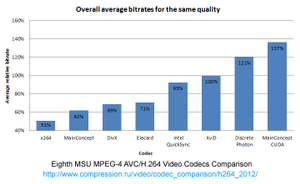
Crunchyroll’s Reduced Premium Video Quality is Either Deliberate Cost-Cutting or Catastrophic Incompetence
On March 11th 2017, people started noticing that something was going on at Crunchyroll. Namely, how the video quality for paying customers seemed to be looking a lot worse than before.
They weren't wrong (as you can see for yourself in this comparison I made) — the bitrate in basically all their premium streams (including 720p and 1080p options) had been essentially halved, leading to notable reduction in quality.
Many people have been wondering if this was some sort of isolated incident or a technical issue of some kind. Well, as you might guess from the title, it's the exact opposite — this was an intentional move that's been a long time in the making.
2017–10–21 UPDATE: I've been occasionally checking random back catalog episodes to see if things have changed for the better throughout their catalog. So far, on all of my attempts, everything I've tested has still had the awful video quality outlined in this post. We still have no timeline from CR for when this issue will be fixed.
2017–03–16 UPDATE: Crunchyroll has put out a technical blog post regarding the reduced video quality. They have also started pushing out new encodes with improved encoding settings, albeit from quick comparing the new encodes are more of a side-step compared to their old ones from before the reduced quality ones. Nevertheless, this means that the vastly reduced video quality will be going away eventually and should not affect new episodes from now on. However, right now basically everything in the back catalog is still affected by the reduced video quality, and Crunchyroll has provided no timeline for fixing this. I wish we'd have gotten more than effectively just a return to the starting point, though. One can hope that Crunchyroll has learned their lesson though and will be improving their video quality further afterward. Maybe one day they will actually start fixing flaws in the sources they get!
I do have to point out one thing from their technical blog post though:
We see these new encodes as the upper end of online streams for anime available anywhere.
This statement is simply not true. Even with the new settings Crunchyroll is still decidedly in the lower end of quality as far as premium anime video quality is concerned.
Just look at the comparison to Anime on Demand from the end of this post — while this uses the old video from before the reduced quality hit for Crunchyroll, it still gives a good indication of much room for improvement there is.
2017–03–15 UPDATE: Crunchyroll has put out a short official statement regarding the reduced video quality, which doesn't actually say all that much. And while they do make a promise to fix things in the future, right now nothing has actually changed — the vast majority of content on Crunchyroll is still available in vastly reduced quality only, and new episodes continue to be converted over to the reduced quality format mere 48 hours after airing. Pirates are still getting better video quality than paying customers, which remains something that just shouldn't happen, period. (UPDATE: see above.)
Some new details have also emerged about the origins of the situation that suggest it could have actually been caused by incompetence (and this is basically what the official statement is claiming as well). I had ruled that possibility out originally due to the fact that it would require failing in a spectacularly catastrophic fashion to screw things up as bad as they did — their video team would literally need to have next to clue whatsoever about what they're doing in order to cause this (as the reduced video quality has been an issue for a better part of a year at this point).
Regardless, I have updated the post title to reflect these findings and will be writing a follow-up post on this later. The original article is below, which currently remains written with the assumption of deliberate cost-cutting (which is honestly the less embarrassing alternative for Crunchyroll). Keep in mind that it does not affect the accuracy of anything else written here though.
So how did we get here?
Back in 2016, people who follow Crunchyroll's actions closely started noticing them using new video encoding settings on some content. While this might sound like potentially good and exciting news at first, the reality was much more alarming — the new videos looked a lot worse than their existing ones.
What's more, they were replacing existing videos with these new worse ones. While new content continued to use older encoding settings with higher bitrate, even they were getting swapped out for worse versions usually around a week later. Over time, the swapping got faster and faster until on March 11th a new milestone was reached: the new worse video was rolled out to a portion of Crunchyroll's userbase instantly, with no access to a higher bitrate version available at any point.

Luckily, this didn't go unnoticed, and the resulting backlash made Crunchyroll roll back on instant deployment of the new low bitrate video... for now. (And only for new episodes — more on that later.)
But while on their own forums you might have seen a support person claim that "this was not intentional" (mind you, said support person was probably just repeating what was told to him, and probably didn't know any better), don't be fooled — again, this was 100% deliberate on Crunchyroll's part.
So why would they do this?
Well, the obvious answer is money: when your video files are half the size they used to be, that's going to save you a pretty penny when it comes to bandwidth costs for moving all that video around to their users.
Of course, the problem with this is that the video quality takes a nosedive as a result. And Crunchyroll didn't exactly have great video quality to begin with — they've basically always had the lowest bitrate premium videos in their niche of digital anime streaming.

So what gives?
Well, there's really only one conclusion to make: Crunchyroll just doesn't really care about video quality, and believe the same goes for their paying customers. This is why they‘ve never said anything about this quality reduction — they thought no-one would notice — and even now it seems like they're trying to sweep it under the rug (see the bit about support saying this change was "unintentional" earlier). Their PR people had pretty clearly also not been informed about the change beforehand, as they had no idea what was going on. Another person's support inquiry about the video quality also resulted in a canned response to the tune of "any video quality problems would be due to an individual's internet connection."
So is everything okay now?
As mentioned earlier, the user backlash made Crunchyroll roll back on the instant deployment of the new low bitrate video. However, this is only for new episodes — all older episodes that have been converted over to the new low bitrate format are only available to paid users in said low bitrate format, and any new episodes are converted over just a day after initial release (2017–03–14 UPDATE: Crunchyroll has increased the switch time to worse video from 24 hours to 48 hours for new content. Obviously, this merely delays the problem slightly and doesn't actually make it go away.).
You can see this for yourself in this comparison, which demonstrates the difference in video quality when the episodes were first released with higher bitrate encodes versus what they look like now with the lower bitrate encodes.
(Episodes used for this: Interviews With Monster Girls 09, Miss Kobayashi's Dragon Maid 04, Saga of Tanya the Evil 03, YURI!!! on Ice 04, Parasyte 15 — note that the last one is a show from Fall 2014, showing that this is very much not limited to recent shows!)

What this means in practice is that if you're not watching something within two days of airing on Crunchyroll, you're getting lower quality video than pirates who can still watch the higher bitrate initial release (since that's what all the pirate rippers grab). And that is some straight-up bullshit. Legal, paying users should not be getting worse quality video than pirates, period.
So what exactly is high quality video anyway?
I've mentioned throughout this post that a massive reduction in bitrate is the primary cause for Crunchyroll's quality drop. If you've made it this far while wondering what exactly bitrate is and why it's so important, let me give you an explanation on three important components of high quality digital video: bitrate, source quality, and encoding settings.
But wait, what about resolution? Many people have the misconception that resolution is the biggest indicator of quality — that if something is HD or Full HD, then it must be good, right? However, this isn't really true. Resolution does matter, but what it actually represents is the maximum potential quality you can have, not the actual quality you're going to get. See, in order for something to be Full HD, the only requirement is basically that the image is either 1920 pixels in width or 1080 pixels in height. That's it. Take a look at the first image below:
If you are skimming through, note that the screenshots above are not intended to be representative of the quality issues this article is about. They are edited images used for demonstrating general problems leading to bad video quality. For actual examples of Crunchyroll's reduced video quality, look for comparison links in highlighted sections similar to this one!
Looks awful, doesn't it? But the resolution of the image is 1920x1080, which means that it still counts as Full HD. The reason the image looks terrible is because it was saved as a very low quality JPG, resulting in a very small filesize. Bitrate basically represents the average filesize for the images that make up a video (as video at its core is just a series of images played one after another). The lower the bitrate, the lower the quality is generally going to be.
Now, take a look a the second image. It is a lossless PNG image. If you were to take this image and save it as a lossy JPG image, no matter how much filesize you allowed the JPG encoder to use, it would still look terrible. And that's exactly why source quality is important. The above image shows exaggerated versions of two of the most common artifacts in anime sources: banding and aliasing. While they are basically unfixable here due to the exaggeration, the banding and aliasing generally found in real video sources can actually be dealt with using appropriate video processing techniques, commonly referred to as filtering.
Last but not least, we have encoding settings. The first thing here is the choice of the video format. The format that pretty much everyone uses these days is H.264/AVC. Next up, you need to choose which encoding software to use. This is actually a very important decision, because encoding a video is like building a house. The video format by itself is merely the toolbox you get to build the house with, while the encoding software is a robot that developers must teach to use the tools in the format's toolbox to build the house with. The better you can teach the encoding software to use the format's tools, the better the resulting compression quality will be.
That's why the choice of encoding software matters. Just using the same video format is not enough to guarantee that you will get the same kind of results in terms of compression quality. When it comes to H.264, the encoding software to choose is x264 — the most advanced H.264 encoding software on the planet. This has been proven in many comparisons, like the following for example:

After this, there are still plenty of choices to make, like what profile to use and various instructions you can give to the encoding software on what features to use (video encoding takes a long time, so for example you may want to tell the encoding software to avoid doing something that would add a lot of additional time to the encoding process for very little gain in quality).
So how does Crunchyroll fare in all this?
Not very well. Starting with the source quality, in many cases the sources they get suffer from the banding and aliasing issues mentioned earlier. Crunchyroll has never done anything to try to fix these or any of the other issues the sources might have, even when extremely severe (if you want a great example of this, just look at Saki). There have also been quite a few cases where they get both bad and good sources for a show and consistently pick the bad one to do their encoding from.
For encoding software, they do use x264, which is good, but they also fail to keep their x264 up to date. Their old higher bitrate encodes are done with an x264 version from 2011, while their new low bitrate encodes are done with a version from 2014. Either way, they're missing out on years of additional improvements in encoding efficiency. You can take a look at the exact encoding settings Crunchyroll uses here. (x264 includes this information in the encoded video files, which is how this information is available.)
What those settings tell to people who understand them is that the new encoding settings are worse in pretty much every way (the only thing you could consider to be better is that they use 5 B-frames instead of just 3). At the end of these settings, we also get to the matter of bitrate: for the old encodes, Crunchyroll uses constant filesize (two-pass) encoding with an average bitrate of ~3000kbps. For the new encodes, Crunchyroll is using constant quality (CRF) encoding with a rate factor of ~22-25. CRF encoding is actually a really good technique, but for 1080p video, truly good quality CRF values will generally be 18 or lower (the lower the better, basically). CRF 22-25 is way above that, which is where the massive bitrate drop comes from in comparison to the old encodes (with the new ones we're looking at average bitrates of ~1000-2000kbps).

So what can Crunchyroll do about this?
The ways Crunchyroll could (and should!) improve on this are fairly simple: first, they should update their x264 so that it's not years out of date. Then they should bring the actual x264 settings for the new encodes at least on par with the old encodes, or preferably make them even better. This will increase encoding time on Crunchyroll's end, but since they are mainly working with video-on-demand, they only need to encode the episodes once (per offered quality level), so this isn't really that big of a problem. And finally, lower the CRF value used so that the bitrates will at least match up with the old encodes, or preferably go even higher. Remember, Crunchyroll already had the lowest premium video bitrates in the industry, and people have been raising complaints about this for years.
Beyond this, it would also be great if Crunchyroll started filtering the sources they get in order to fix the flaws in them. This would require bigger changes to Crunchyroll's video pipeline than the simpler encoding fixes, but seeing as Crunchyroll should really have that "world class video team" put together by now that their CEO Kun Gao said they were building two and a half years ago in a Reddit AMA, it really shouldn't be too much of a problem (or that's what one could expect with statements like that, anyway). Just having a single filter chain per series (ie. have someone who knows what they're doing look at the sources for a series at the start of the show and decide on what filtering to apply to them, if any) would go a long way to improve the situation, because right now banding artifacts are more of a rule than the exception with Crunchyroll's premium video streams.

So what can we do about this?
First of all, spread the word! The more we can make people aware of these issues, the harder time Crunchyroll will have ignoring them. If you're a paying customer, I highly recommend bringing it up on Crunchyroll's forums, as well as sending messages about the poor video quality to them using their support system. Even better, vote with your wallet and straight up cancel your premium subscription, citing poor video quality as the reason. As consumers, we deserve better than this.
So what would be better than this?
For this, we can take a look at the show RE:Hamatora, which was licensed by Crunchyroll for English simulcasting. It was also licensed for German simulcasting by a company called Kazé.
Here is a comparison where you can see how their respective 1080p streams stack up against each other.
The quality difference between the two is quite notable (even when using the old higher bitrate version for Crunchyroll), even though they both had the exact same source files to work with. Why? The explanation is pretty simple: Kazé actually cares about the quality of their video.
2017–03–13 UPDATE: I was linked to another comparison between Crunchyroll's 1080p video and German simulcaster Anime on Demand's video which they call "1080p+" (which is an extra high quality option they offer next to their regular 1080p streams).
Check out the comparison here.
AoD's video here has probably the best quality I've ever seen from a legal digital anime release, only topped by some Italian anime Blu-rays. Notice how they also have actual lyrics and translations for opening & ending songs, something that Crunchyroll basically never bothers to do.
So go out there and make your voice heard. You deserve it. We deserve it. Together, let's make Crunchyroll deliver.



